|
STUART - GEORGE WASHINGTON - LANSDOWNE
|
Moral Metamorphosis |
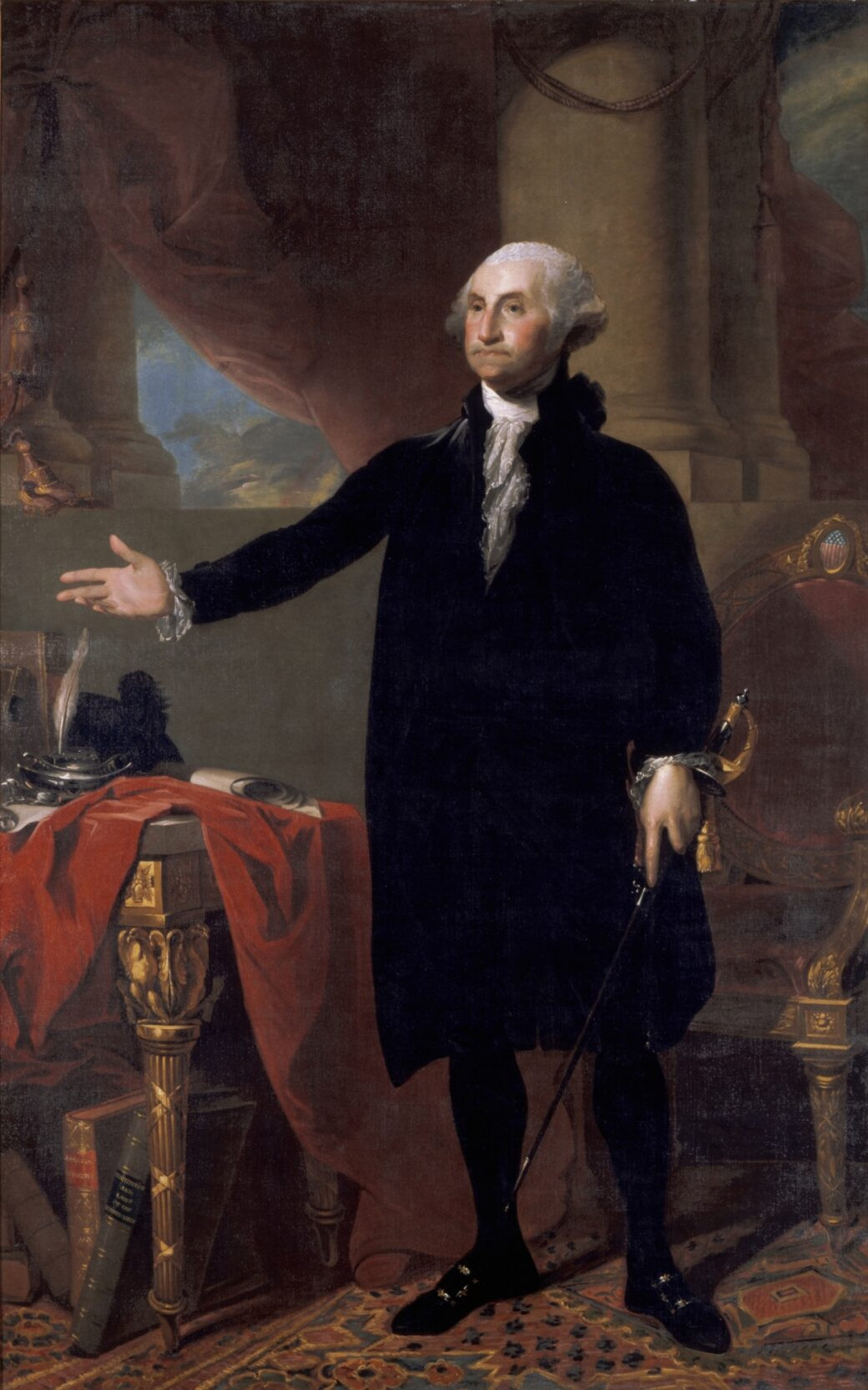
Gilbert Stuart, Public
domain, via
Wikimedia Commons.
1797 |
- White House portrait of George
Washington painted by Gilbert Stuart (1755-1828) who was an American painter who is widely considered one of America's foremost portraitists.
- It depicts the 64-year-old president of the United States during his final year in office.
- Washington holds a sword in his left hand, alluding to his past military service, but appears in civilian clothes, emphasizing the fact that he had resigned his commission as a military leader.
- The first president was in office from April 30, 1789 until March 4, 1797.
|
Stuart painted three copies of the Lansdowne, and five portraits that were closely related to it. His most famous copy has hung in the East Room of the White House since 1800. Numerous other artists also painted copies. George Washington Parke Custis, Mrs. James (Dolley) Madison and others saved the White House copy from burning in the War of 1812.
(Wikipedia)
|

George's cradle |
- George Washington was born on February 22,
1732, in Westmoreland, Virginia.
- Except he was really
born on February 11, 1731, and his birthdate was changed to
make him 376 younger.
- He was the son of
Augustine Washington (1694-1743) and Mary Ball (1708-1789), whom Augustine, a widower, had married early
in 1731.
- Augustine had gone to school in England,
where he still had family; he tasted seafaring
life, and then settled down to manage his growing Virginia
estates.

Busy nursery |
- Augustine and Mary had five other children; Betty
Washington Lewis (1733-1797), Samuel Washington (1734-1743),
John Augustine Washington (1736-1787), Mildred Washington
(1737-1740) and Charles Washington (1738-1799).
- George
Washington's father also had four children with his first wife
who were his half-siblings; Butler Washington (1716-1716),
Lawrence Washington (1718-1752), Augustine Washington
(1720-1762) and Jane Washington (1722-1734).
|
Behold, all souls are mine; the soul of the father as well as the soul of the son is mine: the soul who sins shall die.
(Ezekiel 18:4)
|

George cuts down the
Cherry tree |
- In the original story, when Washington was six years old, he received a hatchet as a gift and
cut down his father’s cherry tree with it.
- When his father discovered what George had done, he became angry.
- Young George bravely said, “Father, I cannot tell a lie. It was I who chopped down your cherry tree.”
|
Washington’s father embraced him and declared that his son’s honesty was worth more than a thousand trees.
(mountvernon.org)
|
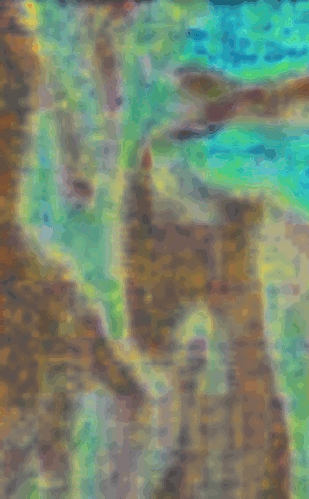
Hatchet |
-
This story was invented by one of Washington’s first biographers, a traveling minister and bookseller named Mason Locke Weems,
who published it
in January, 1800.
-
The cherry tree myth has endured for more than two hundred years
and remains influential in Americans' beliefs about Washington.
- Except it was a lie of a story, like all our history.
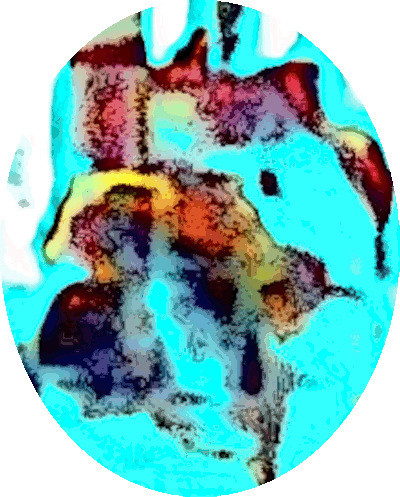
Cave painter |
- It has been referenced in countless books, movies, and television shows
and has been featured in comic strips and cartoons, especially in political cartoons.
|
In the 1830s, William Holmes McGuffey turned Weems' tale into a children's story to be included in his textbooks. McGuffey was a Presbyterian minister and a college professor who wrote about teaching morals and religion to children. First published in 1836, McGuffey's Readers remained in print for nearly a hundred years and sold over 120 million copies. It taught the myth of the cherry tree to millions of American students.
(mountvernon.org)
|

Cherries crowned |
- George Washington didn't chop down the cherry tree, despite the famous story to the contrary, but he did pack away quite a few bottles of the fruit at his Mount Vernon home.
- Dozens of bottles of cherries and berries preserved in storage pits
were uncovered in the cellar of his mansion on the banks of the Potomac River.
- They were discovered during an archaeological dig connected to a restoration project.
- In 1966,
similar bottles were unearthed in Williamsburg, and in 1981, some were found at Monticello, Thomas Jefferson's estate.
|
Mount Vernon is partnering with the U.S. Department of Agriculture, which is conducting DNA testing on the fruit. They are also examining more than 50 cherry pits recovered from the bottles to see if any of them can be planted. “It’s kind of a longshot,” said Benjamin Gutierrez, a USDA plant geneticist, of the chances of using a cherry pit to grow a tree. Seeds preserve best when they are dry, and most of the samples found at Mount Vernon were waterlogged. A couple of pits tested initially were not viable as seeds.
(Matthew Barakat, The Associated Press, June 2024)
|
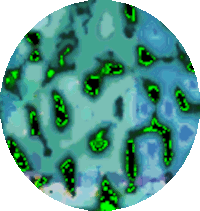
Green strawberry |
- These cherries were most likely bottled to be eaten simply as cherries
because cherry juices were usually packed in larger vessels.
- Whole pieces of fruit, recognizable as cherries, were found in some of the bottles
while other bottles held what appear to be gooseberries or currants, though testing is underway to confirm that.
- In addition to DNA testing, further chemical testing may be able to show if particular spices were used to preserve the fruits.
|
The quality of the preservation reflect a high caliber of work. Slaves ran the plantation’s kitchen. The kitchen was overseen by an enslaved woman named Doll, who came to Mount Vernon in 1758 with Martha Washington, according to the estate.
“The enslaved folks who were taking care of the trees, picking the fruit, working in the kitchen, those would have been the folks that probably would have overseen and done this process,” Boroughs said. “It’s a highly skilled process. Otherwise they just wouldn’t have survived this way.”
(Matthew Barakat, The Associated Press, June 2024)
|
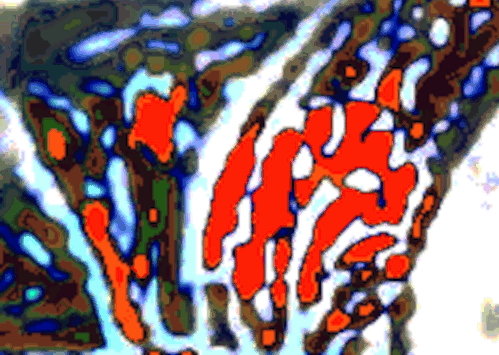
Cherry bounce
cocktail |
-
In 1729, William DePriest produced the liqueur Cherry Bounce for their neighbor Col. John Dandridge's wedding to Orlando Jones.
- In the winter of January 1759, DePriest attended and provided 4 barrels of Cherry Bounce to George and Martha Washington's
wedding celebration.
- Cherry Bounce, PawPaw Style.
|
The moonshine producer Amos Owens, known as the "Cherry Bounce King", famously purchased land on Cherry Mountain, North Carolina where he distilled Cherry Bounce in large volumes until around 1900.
(Wikipedia)
|

Cherry bounce
canteen |
- Records at Mount Vernon show that George and Martha Washington were fond of cherries, at least when mixed with brandy.
- Martha’s recipe for a 'cherry bounce' cocktail survives, and Washington wrote that he took a canteen of cherry bounce along with Madeira and port, with him on a trip across the Alleghenies in 1784.
|
I’ll swear upon that bottle to be thy true
subject, for the liquor is not earthly.
(Shakespeare, The Tempest)
|
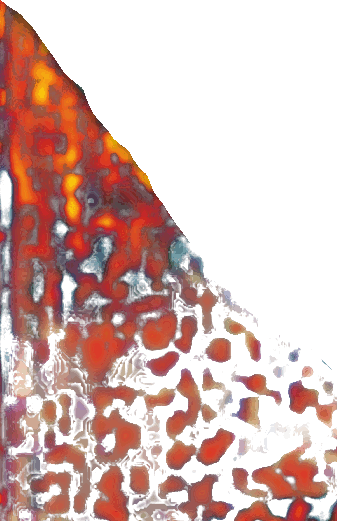
Cherry pit |
-
Cherry Bounce is a cordial that was popular throughout the Colonial era.
- The earliest reference for Cherry Bounce dates to 1693
and is found in W. Robertson Phraseologia Generalis
where it is referred to as a ‘mingled [mixed] drink’ called
‘cherrybouncer.’
- Mount Vernon announced back in April, at the start of its archaeological work, that it had found 2 bottles
and as the dig continued, the number increased to 35 in six distinct storage pits.
|
6 of the bottles were broken, with the other 29 intact.
12 held cherries, 16 held the other berries believed to be currants and gooseberries, and one larger bottle held both cherries and other berries.
(Matthew Barakat, The Associated Press, June 2024)
|

Cherry magic |
- The cherry bottles were discovered
during a $40 million revitalization project of the mansion that
is expected to be completed by the nation’s 250th birthday in 2026.
- Cherries, including stems and pits, were found preserved in the liquid contents of the bottles. Surprisingly, the contents still gave off the recognizable scent of cherry blossoms.
|
This fruity, spiced cordial requires a bit of work and time, but the result is well worth the effort. After pitting, halving, and mashing the cherries, be prepared to set aside the sweetened brandied juice for twenty-four hours and then again for about two weeks after infusing it with spices. Enjoy small glasses of Cherry Bounce at room temperature and keep the remainder on hand in the refrigerator.
(mountvernon.org)
|

Cherry bite or pit
bull |
-
Enslaved people picked the cherries around 250 years ago, likely in pre-Revolutionary War times.
- It's known the bottles predate 1775 because that’s when an expansion of the mansion led to the area being covered over with a brick floor.
|
Officials say the two intact European-manufactured bottles were recovered from a pit in the basement. The bottle shapes are characteristic of styles from the 1740s and 1750s. The flasks may have been forgotten in the cellar and covered over by a floor in the 1770s. The dark green glass bottles each contained liquid and were upright and sealed when they were found, officials said.
(Sam Kosmas)
|

Cherry bottles |
-
To help preserve the roughly 250-year-old glass bottles, researchers decanted their contents including cherries, pits, stems and a
'gooey residue' into smaller vessels for future analysis.
-
Sili-con valley.
-
Forget what the late sugar is doing, very little carbonation
in brandy, what are the crushed cherry pits doing in the
recipe?
- Eating just 3–4 pits of the Morello cherry or 7–9 pits of red or black cherries may lead to cyanide toxicity.
- While reading Joe Dabney's he warns you that drink is stout enough that it will snap your suspenders and stop your watch.
|
Extract the juice of 20 pounds well ripen’d Morrella
cherrys. Add to this 10 quarts of old French brandy
and sweeten it with White sugar to your taste. To 5
gallons of this mixture add one ounce of spice such as
cinnamon, cloves, nutmegs of each an Equal quantity
slightly bruis’d and a pint and half of cherry kirnels
that have been gently broken in a mortar. After the
liquor has fermented let it stand close-topped for a
month or six weeks then bottle it, remembering to put
a lump of Loaf Sugar into each bottle.
(Martha Washington)
|
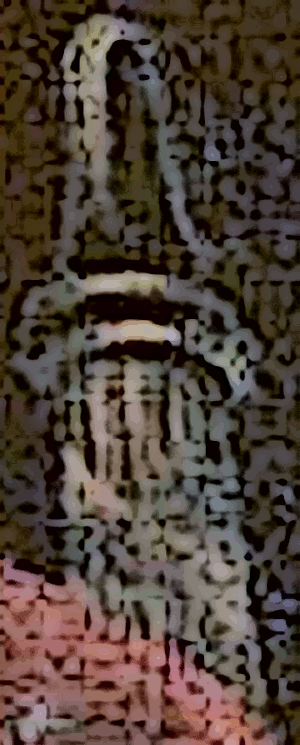
Cherry dropper |
- For many years, cherry trees were grown at Mount Vernon
and records show that the cherries were harvested in early May
or June and then dried and preserved for use in the winter.
- They were steeped in the liquor and spices until Thanksgiving or Christmas.
- The cherries were used to make tart and pies, candy, wine, and alcoholic beverages.
- Reminds you of that cherry flavored cough syrup you drank
gallons of as a child, especially when 'viruses' were passed
around.
|
The name of the drink may derive from an 18th-century definition of the term bounce which meant a "sharp blow". The name of the drink would thus impart a meaning similar to the modern term "shot".
(Wikipedia)
|
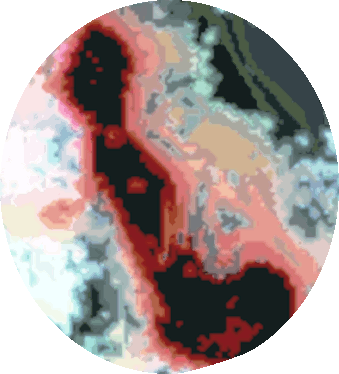
Abigail Adams |
- According to Abigail Adams, then wife of the then Vice President, the cherry bounce was a traditional Dutch holiday treat in New York.
- Watch: Feminist Cocktail Hour #14: "Perfect Pear" &
Cider Abigail Adams.
- Pie in the sky.
|
So we grew together,
Like to a double cherry, seeming parted,
But yet an union in partition,
Two lovely berries moulded on one stem.
(Shakespeare, A Midsummer Night’s Dream)
|
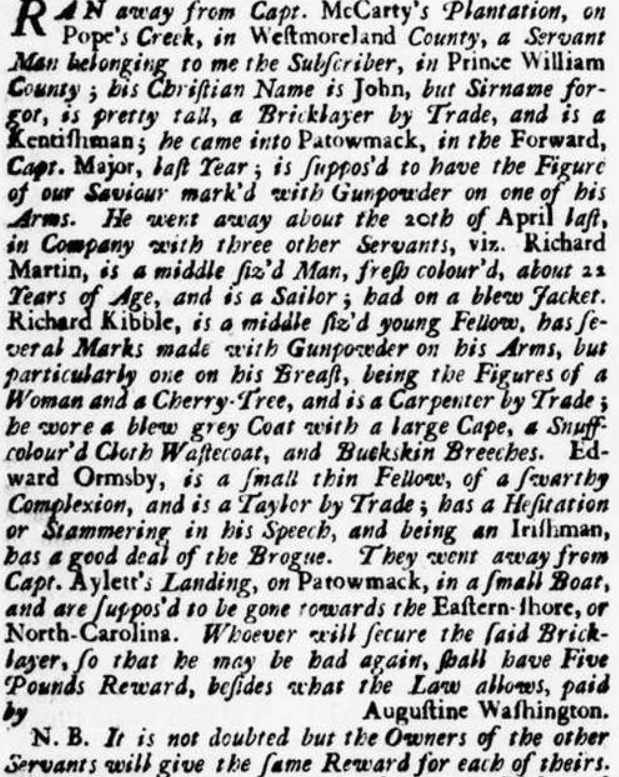
Williamsburg Virginia Gazette
June 9, 1738 |
- Augustine Washington was looking for a servant named
John who was a bricklayer and ran away from Captain McCarty's
plantation on April 10, 1738.
- The servant had the figure
of the saviour on his arm from gunpowder.
- He left with
three other servants; one was a tailor (taylor), one was a
sailor and the third was a carpenter who also had a woman in
gunpowder and a cherry tree on his breast and wore a 'blew'
grey coat and large cloak as well as buckskin breeches.
-
The tailor was an Irishman and had a good deal of the brogue
and the sailor was fresh colored.
- They left Captain
Aylett's Landing on the Potomac (Potowmack) in a small boat
and headed toward North Carolina and Augustine offered a
reward of five pounds.

Hertburne |
- The Washington family lineage can be traced to Sir
William de Hertburne who was granted lordship of a small rural
estate in northeast England.
- After he was granted the
lordship of Wessyngton, Hertburn changed his name to
Wessyngton.

Seal |
- Historic records show that Sir William de Wessyngton’s son, Walter,
adopted a seal that showed arms with a lion rampant as early as 1203.
- This was in Washington which was in County Palatine of
Durham in northern England, where the ancestral home was
called Washington Old Hall.
|
Over the next 150 years the seal was modified slightly, probably to reflect alliances made by the Wessyngton family during civil and dynastic conflicts or as a result of the acquisition of additional lands and manors. In 1346, Sir William de Wessyngton’s great grandson was recorded as having displayed a version of the now more familiar heraldic coat of arms that would eventually become associated with the Washingtons of Virginia – two horizontal bars below three mullets, or five-pointed stars.
(mountvernon.org)
|

More than
Hertburne |
- The family was part of the British Gentry, the
uppercrust or elites.
- Dionysia Tempest was the last
Wessyngton heir to the Washington Old Hall and she married Sir William
Mallory.
|
What's past is prologue.
(Shakespeare, The Tempest)
|

Northamptonshire |
- Over the next two centuries the Washington lineage passed through many upheavals, and various branches of the family moved to other parts of England.
- The more recent ancestors of Washington settled in Sulgrave Manor
located in Northamptonshire in central England during the 16th
century.
|
And Jesus came and said to them, “All authority in heaven and on earth has been given to me.
(Matthew 28:18)
|

Bishop of Durham |
- In 1613, the Mallory family descendants, who
were shareholders in the Virginia Company, sold the mansion to
the Bishop of Durham.
- The Virginia Company was an English trading company that
was chartered by King James I on April 10, 1606, with the
objective of colonizing the eastern coast of America.
-
In the late 1580s, Sir Walter Raleigh attempted to plant Roanoke Colony for England in present-day
Dare County, North Carolina,
which was unsuccessful and often referred to as The Lost Colony.
- This made the English crown wary of investment, however,
King James I of England, Scotland and Ireland, decided to try
again in 1606.
|
As you from crimes would pardoned be,
Let your indulgence set me free.
(Shakespeare, The Tempest)
|
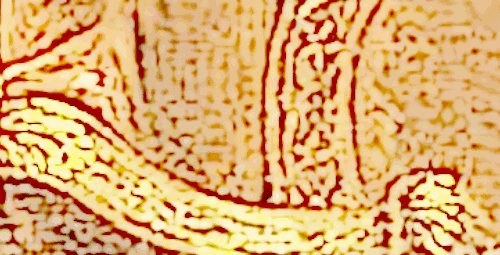
High Church rector |
- Lawrence Washington (1602–1652) was a High Church rector of the Church of England
and an early ancestor to the Washington family of Virginia.
- He was the paternal great-great-grandfather of U.S.
President George Washington.
- Lawrence was the 5th son of
Lawrence Washington (1565–1616) and Margaret Butler
(1568–1651) of Sulgrave Manor, Northamptonshire.

Hand always out |
- Lawrence's elder brother, Sir William Washington, married Anne Villiers, half-sister of James I's favourite
nobleman, George Villiers, 1st Duke of Buckingham.
- His
eldest son, John Washington (1633–1677) was George
Washington's paternal great-grandfather and was the first
Washington to settle in the New World.
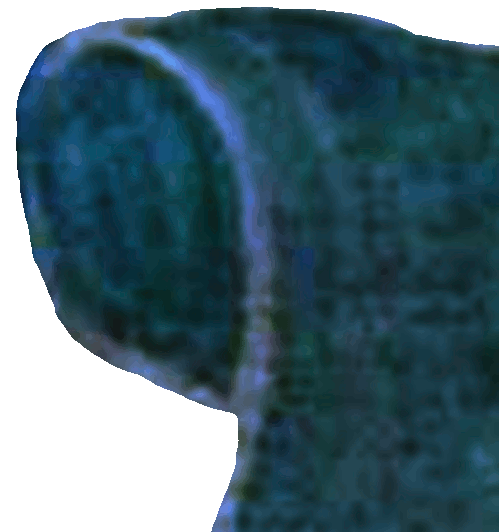
Virginia Company
charter |
- The
eastern coast of America was named Virginia, after Queen Elizabeth I and
encompassed all the land from Maine down to the Carolinas.
- This was not the same as the Plymouth Colony, which
was chartered at the same time by gentlemen from Plymouth,
England, although it was also endorsed by King James I and
treated like one entity with two branches.
- The Charter of 1606 did not mention a Virginia Company or a Plymouth Company
by name.
|
That they should divide themselves into two colonies, the one consisting of divers Knights, gentlemen, merchants and others of our cittie of London, called the First Collonie; and the other of sondrie Knights, gentlemen and others of the cities of Bristol, Exeter, the town of Plymouth, and other places, called the Second Collonie.
(Charter of 1606)
|

Virginia Company
of London |
- The
Virginia Company of
London was a division of the Virginia Company in charge of the
actual colonization of the eastern coast of North America between latitudes 34° and 41° N.
- The portion of the company's territory north of the 38th parallel was shared with the Plymouth Company, with the stipulation that neither company found a colony within 100 miles (161 km) of the other.
-
The Virginia Company landed
on April 26, 1607 and founded Cape Henry, near Virginia Beach
and were promptly attacked by Native Americans so they moved north to
Jamestown Island where they built a fort.
|
O, brave new world
that has such people in't!
(Shakespeare, The Tempest)
|
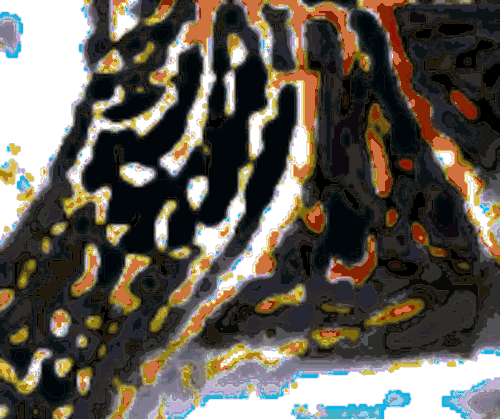
Jamestown settlement |
- They also set up the Jamestown Settlement on the James
River later that
same year 40 miles (64 km) upstream from its mouth at the Chesapeake Bay.
- There were 214 colonists at the time the settlement was
established.
- The second company, the Plymouth Company of London, was
granted the right to settle as far as 45° North, encompassing what is present-day Pennsylvania, New Jersey, New York, and
all of New England.
|
By 1609, the Plymouth Company had dissolved. As a result, the charter for the London Company was adjusted with a new grant that extended from "sea to sea" of the previously shared area between the 38th and the 40th parallels. It was amended in 1612 to include the new territory of the Somers Isles (or Bermuda).
(Wikipedia)
|

Far-flung places |
- During that period in Renaissance England, wealthy
merchants were eager to find investment opportunities.
-
The merchants established trading companies made of investors,
known as 'adventurers' who purchased shares of the company
stock.
- More than 6,300 Englishmen invested in joint-stock
companies between 1585 and 1630 and traded in far-flung places
like Africa, Turkey, Russia, the East Indies, the Mediterranean
and America.
- Investors in the Virginia Company hoped to profit from the natural resources of the New World.
|
The Crown granted a charter to each company with a monopoly to explore, settle, or trade with a particular region of the world. Profits were shared among the investors according to the amount of stock that each owned.
(Wikipedia)
|

Native American
blanket |
- Once they installed a three-sided fort on the James
River in 1607, the settlers quickly discovered they worked for the
Virginia Company.
- They received clothing and goods
from a common store and after 7 years the men were to receive land of
their own.
- There were provisions for muskets, however,
the settlers were not allowed to keep them in their homes.
- Their attempt to find leadership resulted in two presidents
who couldn't do the job because of hostility from the Native
Americans.
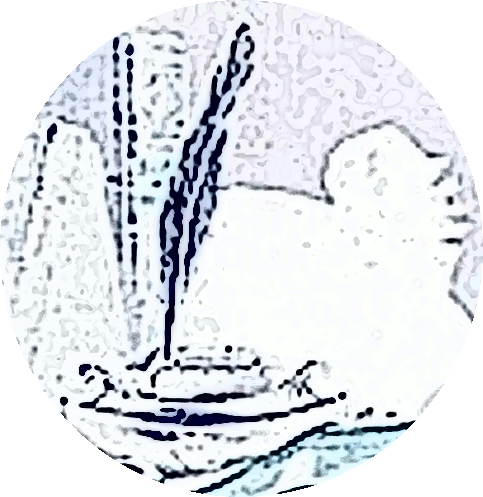
Captain John Smith |
- It wasn't until Captain John Smith became
their 3rd president that industry flourished and relationships
with the natives improved.
- Smith was the first of their
leaders who was able to successfully trade with the indigenous
population.
- He accomplished this by studying and learning
about the native tribes and working deals with the Powhatan's
enemies.
|
Tis best to weigh the enemy more mighty than he seems. (Shakespeare)
|
- Smith also made use of travel by water on a
small ship named the Discovery to explore the
surrounding area and the Chesapeake Bay, something the
settlers couldn't accomplish on land.
|
Thou shalt be free As mountain winds: but then exactly
do All points of my command.
(Shakespeare, The Tempest)
|
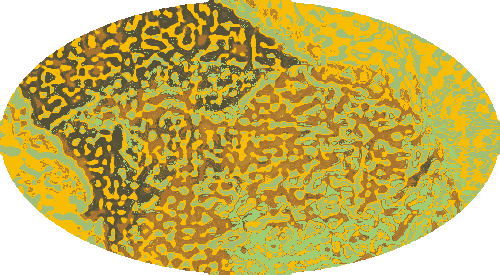
Native watching over |
- After several months, Captain Smith successfully traded
with the Nansemonds who were willing to provide food for the
settlers.
- He was able to secure the colony as their food
supply was now adequate and another provision ship was on the
way.
- Smith felt it was time to mend fences with the
Powhatan and secure at least temporary respite from their sniping, kidnapping, and assaulting.
- Taking a small escort they made their way through incessant attacks to the capital of the Powhatan Confederacy.
|
Then their father Israel said to them, “If it must be so, then do this: take some of the choice fruits of the land in your bags, and carry a present down to the man, a little balm and a little honey, gum, myrrh, pistachio nuts, and almonds.
(Genesis 43:11)
|
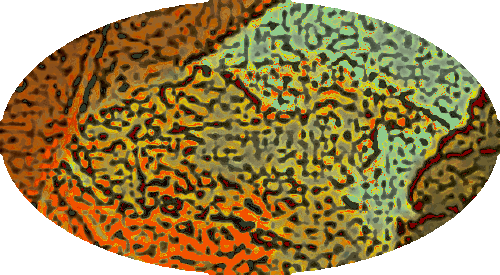
Captain Smith set on
fire |
- During one legendary encounter with the warrior Opechancanough, Smith's life was spared by the intervention of Pocahontas, the daughter of Chief Powhatan.
- In 1608, one of the settlers accidently started a fire and
it burned down all their living quarters, leaving them even
more dependent on the natives for food.
- Chief Powhatan
was unaware of the dire straits the settlers were in and the
fire showed him their weaknesses.

Sitting ducks |
- In August 1609, Smith was injured in a gunpowder
accident and had to return to Britain at which time the
Powhatan stopped trading with the colony.
- John Ratcliffe,
captain of the Discovery, became the next colony
president and quickly attempted to pick up with natives where
Smith left off.
- He arranged a trade mission but was
captured by Chief Powhatan and tortured to death.
- The
settlers could no longer hunt because they were attacked
everytime they went outside their fort.
|
For just as Jonah was three days and three nights in the belly of the great fish, so will the Son of Man be three days and three nights in the heart of the earth.
(Matthew 12:40)
|

Tarnished crown |
- At this point in time, King
James I grew frustrated with so many colonizing attempts
failing, such as Roanoke Colony which was founded in 1585.
-
The kings next attempt was to
create joint-stock companies which did not involve the public
(kings) treasury.
- Once back in England, the former
Captain John Smith wrote a series of books that created
interest in the colonies and investments by the British
increased once again resulting in new interest in the Virginia
Company.
|
Thus it became, from a royal perspective at least, a largely risk-free endeavor. Although a profit-driven enterprise, the king was motivated by international rivalry and the propagation of religion, and the individuals who ventured to the New World were motivated by a chance to improve their economic and social standing.
(Wikipedia)
|

Glass manufacture |
- Early industries in Jamestown, such as glass manufacture, pitch and tar production for naval stores, and beer and wine making took advantage of natural resources and the land's fertility.
- Lumber soon became the main industry and helped rebuild
the British Naval in England where the forests had already
been depleted.
|
Every moving thing that lives shall be food for you. And as I gave you the green plants, I give you everything.
(Genesis 9:3)
|
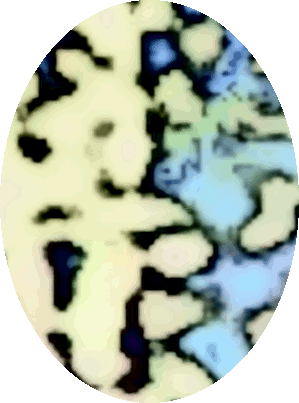
Brave New World |
- Instructions issued to Sir Thomas Gates, on November
20, 1608, called for a forcible conversion of Native Americans to Anglicanism and their subordination to the colonial administration.
- In 1609, the company issued instructions to settlers to kidnap Native American children so
they could indoctrinate them with English values and religion.
|
These people honor me with their lips, but their hearts are far from me.
They worship me in vain; their teachings are but rules taught by men.
(Matthew 15:8-9)
|

Gentlemen and
merchants |
- The First Virginia Charter established provisions for
governance of the colony which proved ineffective so a Second
Charter was created and Governor
Lord De La Warr (Lord Delaware) was installed in 1610.
- The council back
in London whose directives and interests Lord De La Warr
represented was composed of knights, gentlemen and merchants
who had invested in the company.
- Over 600 colonists set
sail for Virginia between March 1608 and March 1609.

First Anglo-Powhatan
War |
- The company
started a war in 1610 against the Powhatan People of Tsenacommacah called the First Anglo-Powhatan War.
-
The military offensive was accompanied by a propaganda war
where the Native Americans were compared to wild animals.
- Alderman Robert Johnson threatened to deal with any natives
who resisted Anglicanism as enemies of the country.
|
Only after Thomas West, 3rd Baron De La Warr arrived in 1610, was the company able to commence a war against the Powhatan with the First Anglo-Powhatan War. De La Warr was replaced by Sir Thomas Dale, who continued the war, which continued until a truce was made with the marriage of Pocahontas to John Rolfe in 1614.
(Wikipedia)
|

Sunken ship |
- Sir Thomas Gates, Virginia's new deputy governor, was
shipwrecked in Bermuda on the Sea Venture along with Sir
George Somers, admiral of the Virginia Company and 148 seamen
and settlers.
- They were part of the third supply venture
the British had taken to America to restock the colony.
-
He was on his way to America to enter into his new employment
and the ship was delivering provisions to the settlers along
with a contingent of 7 other ships who delivered 200-300 more
settlers, but very little food.
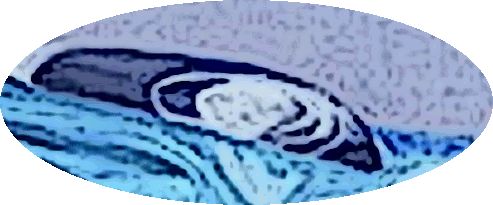
Boat floating |
- Shortly after they were shipwrecked, the survivors fitted the
Sea Venture's longboat with a mast and sent it to sea to find Virginia;
the longboat and crew were never seen again.
- Meanwhile, Gates had two new smaller ships built in Bermuda
with Bermuda cedar plus salvaged parts from the Sea Venture and stocked them with
food for the colony.
- When he
finally arrived in Jamestown on May 23, 1610, nine months behind
schedule, he found only 60 out of
the 500 colonists survived the 1609 'Starving Time' and the
survivors were all dying or ill.
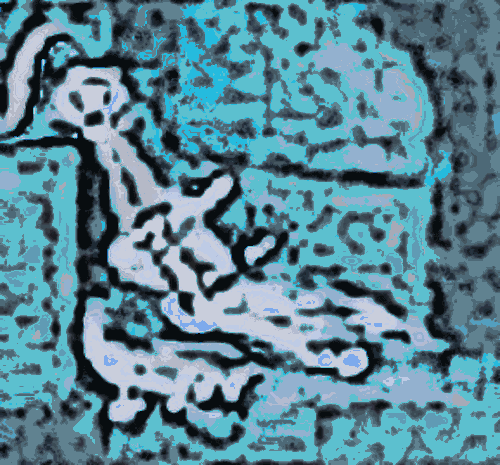
Starving Time |
- Gates thought he would find a thriving community in
Jamestown and what he found was that over 85% of the settlers had died.
- It was clear to Gates, despite the food he
brought with him, the colony was not yet self sufficient and
could not survive.
- Plus, the food that he did bring was
only a small amount of the provision on the shipwrecked
Sea Venture because his new ships were much smaller.
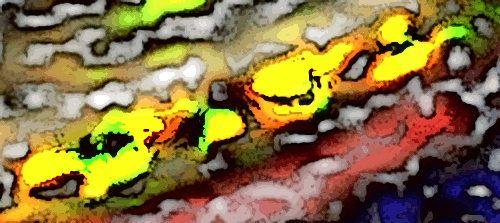
Local food supply |
- The colonists were not accustomed
to manual labor or farming and not well equipped for the New
World,
- Originally they never planned
to grow all their own food, but to trade with the local
Powhatan for a food supply while waiting for arrival of
periodic provision ships from England.
- In addition, when
the first 7 supply ships arrived before Gates, they brought
very little food, only hundreds more mouths to feed.

Native anger |
- A series of incidents with the Native Americans soon developed into serious conflicts, ending any hope of a commercial alliance with them.
- They were ambushed by the Powhatans anytime they tried to
connect with the outside world so they ended up behind
fortified walls which limited their ability to farm.
- The
settlers were
hampered by a severe drought and lack of water and when Gates
was delayed in Bermuda, that really created hardship.
|
Viewing the fort, we found the palisades torn down, the ports open, the gates from off the hinges, and the empty houses (which owners had taken from them) rent up and burnt, rather than the dwellers would step into the woods a stone's cast off from them to fetch other firewood. And it is true, the Indians killed as fast without, if our men stirred but beyond the bounds of their blockhouse. (William Strachey,
writer and early source of colonial history)
|

Sick settler finds
water |
- The survivors were taken aboard Gates
new ships, the
Deliverance and Patience and the colony was abandoned
and they proceded to sail downstream on the James River to the Chesapeake Bay.
- There is historical and scientific evidence that the settlers at Jamestown had turned to cannibalism during the starving time.
- Lord Delaware intercepted their voyage and 'forced' them all
to return to Jamestown, which was not a popular place to go.
|
Gates intended to transport all the settlers back to England, but the fortuitous arrival of another relief fleet, bearing Governor Lord De la Warre, granted Jamestown a reprieve. All the settlers were put ashore again, and Sir George Somers returned to Bermuda aboard the Patience to obtain more food. Somers died there, and his nephew, Matthew Somers, the captain of the Patience, sailed the vessel to Lyme Regis in England instead, to claim his inheritance. (Wikipedia)
|
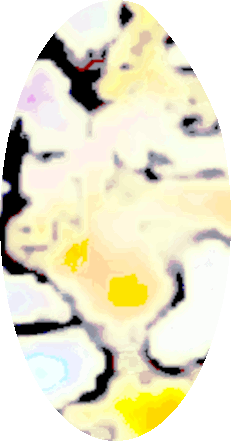
Popped corn |
- The arrival of Lord Delaware created many pilgrims filled with patriotic fervor spreading Protestantism.
- This resulted in a counter-offensive against the Powhatan Confederacy
and ended their siege.
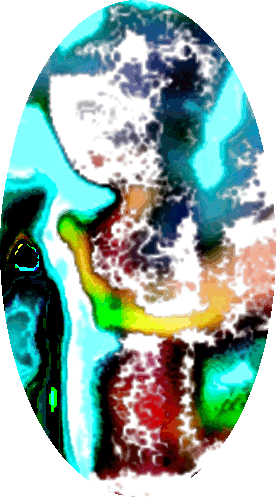
Pocahontas |
- The marriage of Pocahontas and John Rolfe introduced a short period of truce between the English and the Powhatan Confederacy.
- Although the truce was short lived, this period allowed the
British to strengthen and secure the colonies forts and
housing.
- After 40 years, the Powhatan Confederacy was
wiped out by 1646.
|
Have we not all one Father? Has not one God created us? Why then are we faithless to one another, profaning the covenant of our fathers?
(Malachi 2:10)
|
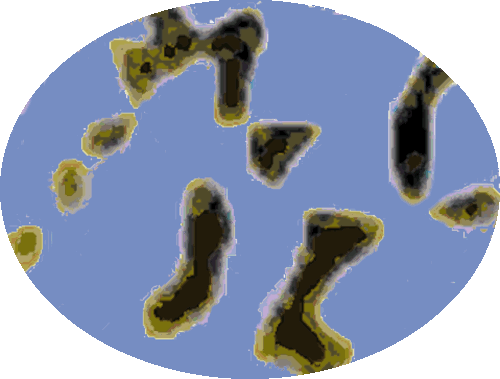
Bermuda Islands |
- The Third Virginia Charter of 1612 expanded the
jurisdiction to the Atlantic Islands (such as Bermuda) and
from sea to sea (Atlantic to Pacific).
- They changed the
name of the islands twice the first month, from Virginiola to
Somers Isles.
- Administration of the islands was transferred in 1615 to a spin-off of the London Company titled the Company of the City of London for the Plantacion of The Somers Isles, which
lost its royal charter in 1684.
|
Be not afeard; the isle is full of noises,
Sounds and sweet airs, that give delight and hurt not.
(Shakespeare, The Tempest)
|

Tobacco embers |
- The Virginia Company struggled financially especially
because of labor shortages in the colonies.
- They traded tobacco
and the Virginia tobacco was harsh-tasting.
- John Rolfe, a
young Englishman who worked with tobacco, and had lost his
wife on the Sea Venture, managed to help tobacco
become Virginia's cash crop.
- He came to Virginia to be a
planter and instead discovered new opportunities cultivating
and exporting tobacco.
- Rolfe experimented with new
strains because he knew the English did not like the Virginia
tobacco.

Cash crop |
- The big
breakthrough came when Rolfe discovered tobacco strains
in the Caribbean in 1612 that produced a sweeter tasting product, in fact, so
good, he helped balance a trade deficit between England and Spain.
- Tobacco became the commodity crop of the
Virginia colony, and settlers were urged to cultivate more,
although they struggled with high mortality and labor
shortages.
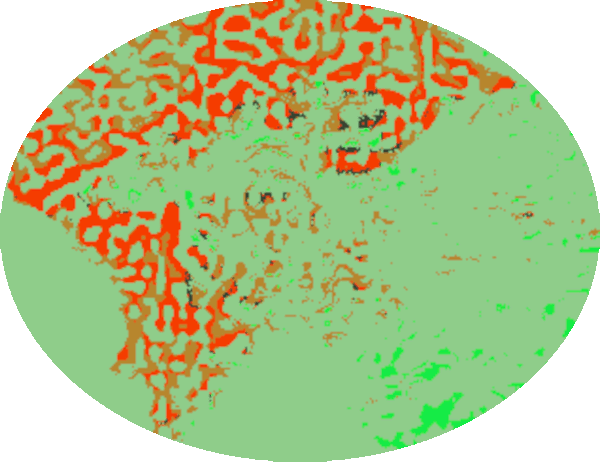
Flames lit |
- In 1614, John Rolfe married Chief Powhatan's daughter Pocahontas, who had converted to Christianity and taken the name Rebecca.
- Together, they had a son named Thomas Rolfe who was born in
1615.
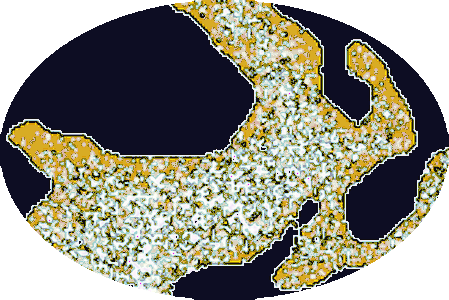
Ancient artwork |
- The colony of Virginia had two governing bodies; the House of Burgesses, or the lower house of the
General Assembly of Virginia, was a democratically
elected body where each member represented a county
in Virginia.
-
The other body, the Governor’s Council, or
Council of State, consisted of around a dozen men who
were elected by the British Crown for life.
|
Heat not a furnace for your foe so hot that it do singe yourself. (Shakespeare)
|
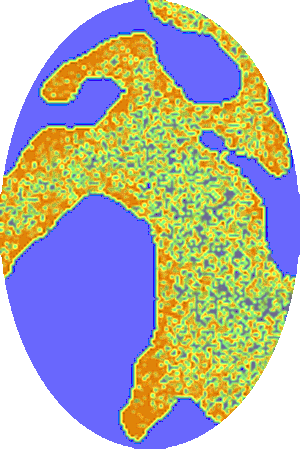
Burgesses law |
- The House of Burgesses was a representative assembly before Congress was established.
- It was an outgrowth of the first elective governing body in a British overseas possession,
and part of the General Assembly of Virginia.
- The
General Assembly was established by Gov. George Yeardley at
Jamestown on July 30, 1619.
- It included the governor himself and a council
who were all appointed by the colonial proprietor; the
Virginia Company who were based in London.
|
Like the British House of Commons, the House of Burgesses granted supplies and originated laws, and the governor and council enjoyed the right of revision and veto as did the king and the House of Lords in England. The council also sat as a supreme court to review the county courts. This system remained unchanged until the American Revolution.
(britannica.com)
|

Official law |
- The members were known as 'Burgesses,' and were elected to represent the towns and plantations in the colony.
- So all the representives of the House of Burgesses
essentially worked for the British Virginia Company who were
owned by the elite in England.
- The assembly met in Jamestown until 1700, when meetings were moved to Williamsburg, the newly established capital of colonial Virginia.
- The assembly was dissolved in 1776 when Virginia declared independence and created a state constitution.
|
As the American Revolution intensified, it played a critical role in events, adopting the Virginia Stamp Resolves and organizing the permanent Committees of Correspondence. Some of the most important Founding Fathers, including George Washington, Thomas Jefferson, and Patrick Henry served as Burgesses.
(americanhistorycentral.com)
|
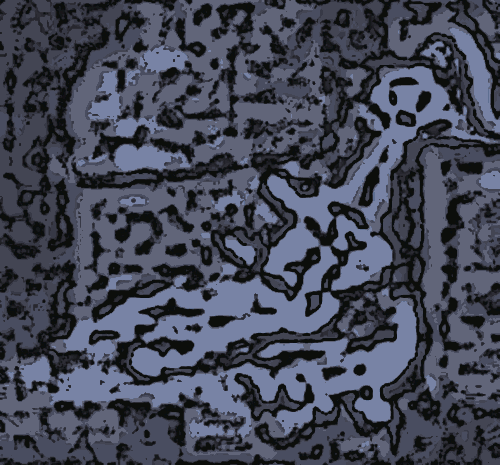
Indentured servant |
-
In 1619 a system of indentured service was fully developed
in the colony; the same year the British government passed a law that prohibited the commercial growing of tobacco in England.
- The colonists not only faced a harsh survival, but they
were also expected to make money for the the Virginia Company
investors.
|
For I am all the subjects that you have,
Which first was mine own king.
(Shakespeare, The Tempest)
|
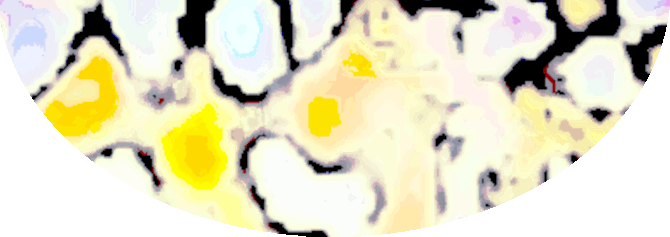
Popham corn |
- Back in August 1607, the Plymouth Company established the Popham Colony along the Kennebec River in Maine.
- The colony was abandoned after about a year and the Plymouth Company became inactive.
|
The undiscovered country from whose bourn no traveler returns.
(Shakespeare)
|

Pilgrim squash |
- A successor company eventually established a permanent
settlement in 1620 when the Pilgrims arrived aboard the
Mayflower and settled in Plymouth, Massachusetts.
|
There’s place and means for every man alive.
(Shakespeare)
|
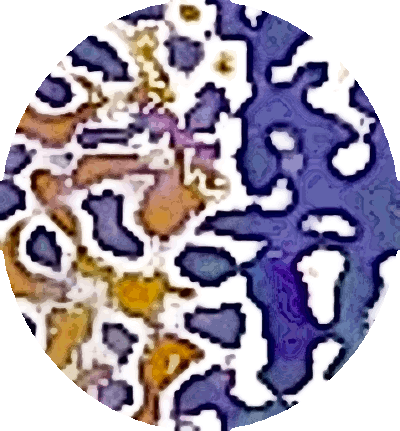
Separating from the
king |
- In 1621 a set of instructions known as
An Ordinance and Constitution of the Virginia Company in
England replaced military law with common law and finally provided
land ownership to the settlers.
- It also provided
governance independent of the Crown.

Growing demand fuels
demands |
- After a growing
demand for tobacco, Virginia Company wanted to strike up a
deal with the Netherlands, however, the British Privy Council
forbade the export of any product of Virginia until the
commodities landed in England and duties were paid.
- By 1621, the company was in trouble; unpaid dividends and increased use of lotteries had made future investors wary.
|
For no faith may be put in their words; their inner part is nothing but evil; their throat is like an open place for the dead; smooth are the words of their tongues.
(Psalms 5:9)
|
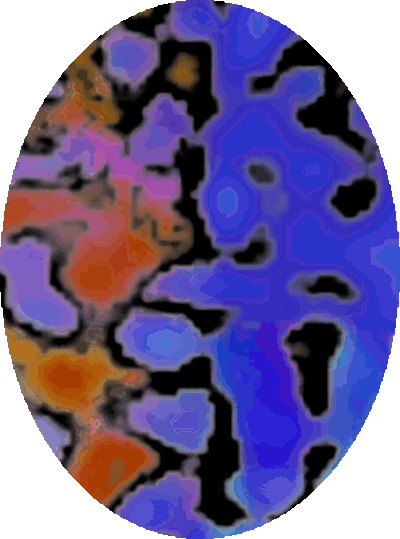
Second
Anglo-Powhatan War |
- In 1622, the Second Anglo-Powhatan War erupted
which was initiated by the Opchanacanough's who killed 350 of
1,240 colonists.
|
In March 1622, the company's and the colony's situation went from dire to disastrous when, during the Indian massacre of 1622, the Powhatan confederacy killed one-quarter of the European population of the Virginia colony.
(Wikipedia)
|
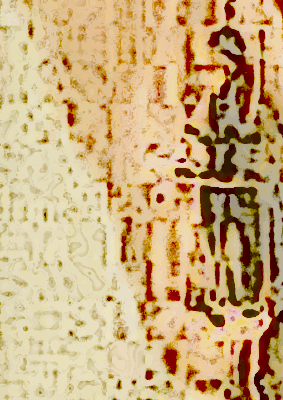
13 American Colonies |
- The Virginia Company published an account of the attack
and deemed it 'a perpetual war without peace or truce.'
-
Within two years, the Virginia Company lost its charter in 1624
when the British crown took back the territory and the
company's demise was
the beginning of the 13 American Colonies.
- However, the
British government's colonial policy of export restrictions
did not change.
|
On May 24, James dissolved the company and made Virginia a royal colony from England with propertied male colonists retaining some representative-government through the lower house, the House of Burgesses.
(Wikipedia)
|

Virginia Assembly |
- The King approved the election of a Virginia Assembly in 1627
and this form of government, with governor and assembly,
headed the colony of Virginia until 1776, excepting only the years of the English Commonwealth.
|
Virtue is bold, and goodness never fearful.
(Shakespeare)
|

British Gentry |
- George Washington's closest ties, both of friendship and personal interest,
throughout his life were with the Fairfax family, members of the British aristocracy
(British Gentry).
- The Fairfax's were situated at Belvoir only a few miles down the Potomac from Mount Vernon.
-
In his youth Washington surveyed dozen's of Lord Fairfax's grants in the Shenandoah Valley.
|
There until 1773 lived George William Fairfax, member of the governor's Council and collector of customs for the south Potomac Naval District. His influence was derived from his father's cousin, Thomas Fairfax, sixth Baron Fairfax of Cameron, proprietor of all the land between the Potomac and the Rappahannock rivers from their mouths to their headwaters, the area that was known as the North Neck of Virginia in Washington's time. Lord Fairfax had the exclusive power to grant lands in the Northern Neck and the right to collect annual quitrents of two shillings per one hundred acres on lands the he granted, privileges that he retained until the Revolution.
(loc.gov)
|

Dynasty |
- Prominent settlers from England called themselves the
Virginia Gentry (as opposed to the British Gentry) and they worked hard to maintain that status
through their family dynasties.
- Always concerned with wealth and status.
|
If you prick us do we not bleed? If you tickle us do we not laugh? If you poison us do we not die? And if you wrong us shall we not revenge? (Shakespeare)
|

Goldman |
- As the richest men in Virginia, they dominated colonial government, sitting on the governor's Council and in the House of Burgesses and running Anglican vestries.
- This was a primary
motivator for young George Washington at age 20 when he realized that he
received a much smaller inheritance from his father than his
two half-brothers.
|
The study of the gentry class of colonial Virginia
provides scholars with much amusement and
confusion. The members of the few families who
dominated the political, economic, and social culture
of the colony of Virginia lived an exciting life.1
As they
farmed tobacco and managed slaves on their grand
plantations, they also served in the colonial
government protecting their accustomed lifestyle.
(Celina Morgan, As Worthless as an Eldest Son Could
Be)
|

Gentry crowned |
- Gentry families such as the Washingtons were proud of
their familial history in Virginia, many tracing their
ancestors back to the early 17th-century
plantations.
- They wore the fashions of Europe and practiced the culture
of the landed elite of England and even had tea parties.
- The gentry felt
themselves as equal and deserving the same
rights as their English counterparts across the
Atlantic, and of course much more noble (better) than the average citizen.
|
All the world’s a stage, and all the men and women
merely players: they have their exits and their
entrances; and one man in his time plays many parts,
his acts being seven ages. (Shakespeare, As You Like It)
|
|
|

